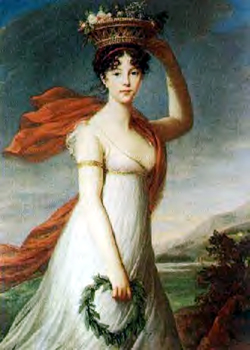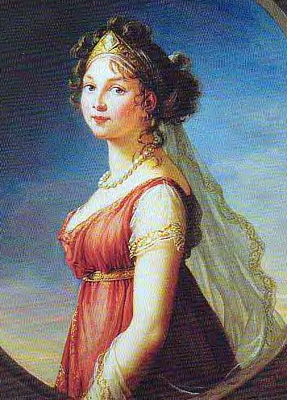 on elegance and simplicity which was motivated by the democratic
on elegance and simplicity which was motivated by the democraticideals of the French Republic but which looked back to classical
Greece and Rome for its fashion inspiration. Waists were high, the
directional emphasis was vertical, and lightweight white fabrics
were at the height of fashions which were so simple that the lady
of the time often wore only three garments; a chemise, a corset
and a gown! This was an incredible contrast to the clothing of preceding
and succeeding periods with their horizontal emphases, multiple
layers and often heavy fabrics.
 Chemise:
Chemise:The chemise was the only ladies' undergarment used during the era.
(Panties would not be developed until the 20th century and pantalets
were not in vogue until Victorian times.) The chemise was simply
constructed of linen or cotton. In modern terms its appearance was
similar to a long blouse or short nightgown.
Corset:
In the early days of the Regency era some women wore tight but
lightweight linen stays which had an effect similar to a modern
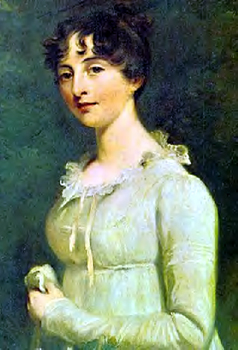 push-up bra while some chose to wear no support at all. The ideal
push-up bra while some chose to wear no support at all. The ideal was to emulate the "classical" Greek look of ancient statuary and the
older conical shaped stays of the Georgian era didn't do the trick.
But soon new corset designs had caught up in "support" of the latest fashions.
The corset was worn over the chemise, was typically made of linen,
laced in the back, was “boned” for firmness and often had a long
wooden or whalebone busk in the front to create the “lift and separate”
support necessary for Regency fashions. A lady wearing a proper Regency style
corset will likely carry herself with flawless posture.
Gown or Dress:
The gown was at least ankle length and had a very high “empire” waist.
Some bodices scooped quite low in front and/or back while others
were more moderate. Some had trains in the rear which were pinned
up while dancing. The sleeves could be short or wrist length as each style
was popular at different times. Even a few sleeveless gowns were
seen early in the period. The fabric was usually light in color with solid
white being the favorite of the era. Small patterns and vertical stripes were
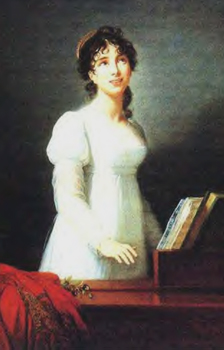 also used. Good fabric choices would be lightweight such as cotton batiste,
also used. Good fabric choices would be lightweight such as cotton batiste,lightweight cotton muslin or a silk such as charmeuse that isn’t too
stiff but has a good “drape” to it. Sometimes a very light semi-transparent
overdress was worn on top of the main article. White cotton voile or
silk chiffon might be good fabrics for such an option. Trim could be in
the form of piping, metallic braid or ribbon.
Spencer Jacket:
The Spencer Jacket was an item peculiar to the Regency period which
went well with the empire waist gown. It was very fitted, had either a
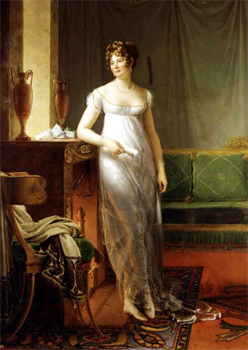 standing or flat collar and could have short or long sleeves. The bottom
standing or flat collar and could have short or long sleeves. The bottom of the jacket conformed level with the high waist of the gown
. Spencer Jackets were often made of linen though wool or silk could be used.
Stockings:
Stockings were often silk or cotton and came up to thigh level.
Shoes:
Low shoes similar to modern lace-up ballet slippers were used as
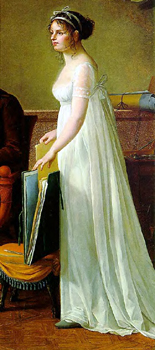 were leather, lace-up shoes with a heel.
were leather, lace-up shoes with a heel.Hats and Bonnets:
The poke bonnet was the very popular, signature headwear for ladies
of the period. It was long and scoop shaped, sometimes compared
unfavorably to a coal scuttle in appearance. Critics of the era’s
fashions (often older folks who longed for the “good old days” of the
18th century) represented women in both satire and cartoon as
running about in their underwear (lightweight, diaphanous gowns)
with comically long headwear (poke bonnets) for hiding their faces in!
Straw “cartwheel” hats, often plumed, were very popular both before
and into the 1790s and would have a resurgence in popularity in future
decades as well. Turbans and ostrich feathers were quite in vogue
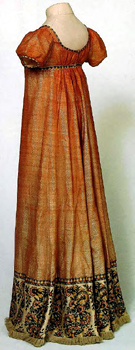 for a time, particularly for formal occasions, as were diadems.
for a time, particularly for formal occasions, as were diadems.Hair:
Ladies’ hair was quite fashionable when piled high on the head in a
classically inspired style with hanging wisps, curly bangs and ringlets
about the face.
Accessories:
Small purses which shut by means of a drawstring were popular.
Jewelry was worn but for most women tended to be less
ostentatious than that of their 18th century counterparts.
For example, a small gold, silver or pewter cross on a short,
simple chain worn around the neck was considered very tasteful
and was the height of fashion during the first two decades of the
19th century. In fact, Jane Austen herself wore just such an item.
Hand painted miniatures, (cameos with portraits painted on them)
were popular as well.
